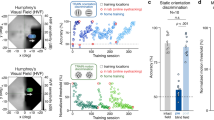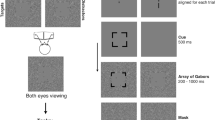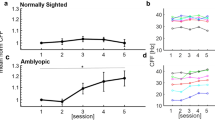Abstract
Damage to the optic radiation or the occipital cortex results in loss of vision in the contralateral visual field, termed partial cortical blindness or hemianopia. Previously, we have demonstrated that stimulation in the field defect using visual stimuli with optimal properties for blindsight detection can lead to increases in visual sensitivity within the blind field of a group of patients. The present study was aimed to extend the previous work by investigating the effect of positive feedback on recovery of visual sensitivity. Patients’ abilities for detection of a range of spatial frequencies within their field defect were determined using a temporal two-alternative forced-choice technique, before and after a period of visual training (n = 4). Patients underwent Neuro-Eye Therapy which involved detection of temporally modulated spatial grating patches at specific retinal locations within their field defect. Three patients showed improved detection ability following visual training. Based on our previous studies, we had hypothesised that should the occipital brain lesion extend anteriorly to the thalamus, little recovery would be expected. Here, we describe one such case who showed no improvements after extensive training. The present study provides further evidence that recovery (a) can be gradual and may require a large number of training sessions (b) can be accelerated using positive feedback and (c) may be less likely to take place if the occipital damage extends anteriorly to the thalamus.




Similar content being viewed by others
References
Balliet R, Blood KM, Bach-y-Rita P (1985) Visual field rehabilitation in the cortically blind? J Neurol Neurosurg Psychiatry 48(11):1113–1124
Barbur JL, Ruddock KH, Waterfield VA (1980) Human visual responses in the absence of the geniculo-calcarine projection. Brain 103(4):905–928
Barbur JL, Harlow AJ, Weiskrantz L (1994) Spatial and temporal response properties of residual vision in a case of hemianopia. Philos Trans R Soc Lond B Biol Sci 343(1304):157–166
Blythe IM, Kennard C, Ruddock KH (1987) Residual vision in patients with retrogeniculate lesions of the visual pathways. Brain 110(4):887–905
Cowey A (2004) Fact, artefact and myth about blindsight. Q J Exp Psychol 57A:577–609
Fahle M, Edelman S, Poggio T (1995) Fast perceptual learning in hyperacuity. Vis Res 35:3003–3013
Goebel R, Muckli L, Zanella FE, Singer W, Stoerig P (2001) Sustained extrastriate cortical activation without visual awareness revealed by fMRI studies of hemianopic patients. Vis Res 41:1459–1474
Henriksson L, Raninen A, Näsänen R, Hyvärinen L, Vanniet S (2007) Training-induced cortical representation of a hemianopic hemifield. J Neurol Neurosurg Psychiatry 78:74–81
Herzog MH, Fahle M (1997) The role of feedback in learning a vernier discrimination task. Vis Res 37:2133–2141
Hess RF, Pointer JS (1989) Spatial and temporal contrast sensitivity in hemianopia. A comparative study of the sighted and blind hemifields. Brain 112(4):871–894
Huxlin KR (2008) Perceptual plasticity in damaged adult visual systems. Vis Res 48(20):2154–2166
Huxlin KR, Martin T, Kelly K, Riley M, Friedman DI, Burgin WS, Hayhoe M (2009) Perceptual relearning of complex visual motion after V1 damage in humans. J Neurosci 29(13):3981–3991
Julkunen L, Tenovue O, Jaaskelainen S, Hamalainen H (2003) Rehabilitation of chronic post-stroke visual field defect with computer-assisted training. Restor Neurol Neurosci 21:19–28
Kasten E, Wust S, Behrens-Baumann W, Sabel BA (1998) Computer-based training for the treatment of partial blindness. Nat Med 4:1083–1087
Kasten E, Bunzenthal U, Sabel BA (2006) Visual field recovery after vision restoration therapy (VRT) is independent of eye movements: an eye tracker study. Behav Brain Res 175:18–26
Kentridge RW, Heywood CA, Weiskrantz L (1999) Effect of temporal cueing on residual visual discrimination in blindsight. Neuropsychologia 37:479–483
Kentridge RW, Heywood CA, Weiskrantz L (2004) Spatial attention speeds discrimination without awareness in blindsight. Neuropsychologia 42:831–835
Marzi CA, Tassinari G, Agliotti S, Lutzemberger L (1986) Spatial summation across the vertical meridian in hemianopics. A test of blindsight. Neuropsychologia 24(6):749–758
McKee SP, Westheimer G (1978) Improvement in vernier acuity with practice. Percept Psychophys 24:258–262
Mohler CW, Wurtz RH (1977) Role of striate cortex and superior colliculus in visual guidance of saccadic eye movements in monkeys. J Neurophysiol 40:74–94
Moore T, Rodman HR, Repp AB, Gross CG (1985) Localisation of visual stimuli after striate cortex damage in monkeys: parallels with human blindsight. Proc Natl Acad Sci USA 92:8215–8218
Pambakian ALM, Mannan SK, Hodgson TL, Kennard C (2004) Saccadic visual search training: a treatment for patients with homonymous hemianopia. J Neurol Neurosurg Psychiatry 75:1443–1448
Poggel DA, Kasten E, Sabel BA (2004) Attentional cueing improves vision restoration therapy in patients with visual field defects. Neurology 63(11):2069–2076
Reinhard J, Schreiber A, Schiefer U, Kasten E, Sabel BA, Kenkel S, Vonthein R, Trauzettel-Klosinski S (2005) Does visual restitution training change absolute homonymous visual field defects? A fundus controlled study. Br J Ophthalmol 89(1):30–35
Sabel BA (2008) Plasticity and restoration of vision after visual system damage: an update. Restor Neurol Neurosci 26(4–5):243–247
Sahraie A (2007) Induced sensitivity changes in chronic hemianopia. Curr Opin Neurol 20(6):661–666
Sahraie A, Trevethan C, Weiskrantz L, Olson J, MacLeod M-J, Murray AD, Dijkhuizen RS, Counsell C, Coleman R (2003) Spatial channels of visual processing in cortical blindness. Eur J Neurosci 18(5):1189–1194
Sahraie A, Trevethan CT, MacLeod M-J, Murray AD, Olson JA, Weiskrantz L (2006) Increased sensitivity following repeated stimulation in blindsight. Proc Natl Acad Sci USA 103(40):14971–14976
Sahraie A, Trevethan CT, MacLeod M-J (2008) Temporal properties of spatial channels of processing in hemianopia. Neuropsychologia 46:879–885
Seitz AR, Watanabe T (2003) Psychophysics: is subliminal learning really passive? Nature 422:36
Stoerig P (1987) Chromaticity and achromaticity. Evidence for a functional differentiation in visual field defects. Brain 110(4):869–886
Stoerig P (2006) Blindsight, conscious vision, and the role of primary visual cortex. Prog Brain Res 155:217–234
Trevethan CT, Sahraie A (2009) Blindsight. In: Banks WP (ed) Encyclopedia of consciousness, vol 1. Elsevier, Oxford, pp 107–122
Weiskrantz L (1997) Consciousness lost and found. Oxford University Press, Oxford
Weiskrantz L (2009) Blindsight: a case study spanning 35 years and new developments. Oxford University Press, Oxford
Yukie M, Iwai E (1981) Direct projections from the dorsal lateral geniculate nucleus to the prestriate cortex in macaque monkey. J Comp Neurol 201:81–97
Zhang X, Kedar S, Lynn MJ, Newman NJ, Biousse V (2006a) Natural history of homonymous hemianopia. Neurology 66(6):901–905
Zhang X, Kedar S, Lynn MJ, Newman NJ, Biousse V (2006b) Homonymous hemianopias: clinical-anatomic correlations in 904 cases. Neurology 66(6):906–910
Zihl J, von Cramon D (1985) Visual field recovery from scotoma in patients with postgeniculate damage: a review of 55 cases. Brain 108:335–365
Acknowledgments
We would like to thank Mr. James Urquhart for technical support, Dr. Nicola Ridgway for help with data collection; Prof. John Crawford for discussions of single case statistics; and Prof. Peter McGeorge and Dr. David Carey for extensive, scholarly and insightful comments on earlier versions of the manuscript. AS and MJM are directors of Aberdeen University spin out Sight Science Ltd.
Author information
Authors and Affiliations
Corresponding author
Rights and permissions
About this article
Cite this article
Sahraie, A., MacLeod, MJ., Trevethan, C.T. et al. Improved detection following Neuro-Eye Therapy in patients with post-geniculate brain damage. Exp Brain Res 206, 25–34 (2010). https://doi.org/10.1007/s00221-010-2395-z
Received:
Accepted:
Published:
Issue Date:
DOI: https://doi.org/10.1007/s00221-010-2395-z




